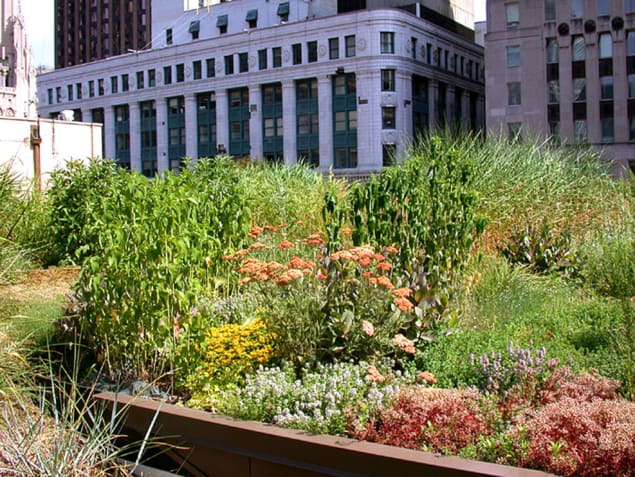Computer model picks which roofs to make green
23 Oct 2018 Liz Kalaugher
The installation of green roofs in cities to reduce the “urban heat island” effect should take into account which areas are hottest, which people are most vulnerable and where air-conditioning usage is highest, say researchers in the US. The effect describes the heightened air temperatures of cities relative to the surrounding countryside.
Using computer models to include all these factors, the researchers found that in the US city of Chicago, areas to the south and west, as well as certain other isolated areas, would benefit most from green roof installation.
The methodology can and should be applied to other places that suffer from the urban heat island effect, the researchers say.
“Green roofs are one of the effective strategies to mitigate urban heating,” says Ashish Sharma of the University of Notre Dame, US. “However, the placement and implementation of green roofs … should have a scientific basis, which should include interdisciplinary experts.”
A green roof is a garden built on top of a roof and planted with drought-tolerant plants. The plants intercept sunlight and transpire, taking water in through their roots and transporting it to their leaves, where it evaporates. This cools the roof down, whereas a roof made of conventional materials would simply heat up.
According to the US National Weather Service, heat is the deadliest weather hazard in the US, with an average of 130 people losing their lives to heat stress every year between 1986 and 2015. In July 1995, an unprecedented heat wave was believed to cause over 700 deaths in Chicago. To tackle this problem, town planners in Chicago are hoping to install 6,000 green roofs in the city by 2020.
To determine the best places for these green roofs, Sharma and colleagues compiled indices of social vulnerability based on people’s exposure to urban heat, their sensitivity to it, and their ability to adapt. The team combined these vulnerability indices with high-resolution temperature simulations of Chicago rooftops and data on the consumption of electricity for air conditioning units.
The output was a map that showed where in Chicago green roofs would deliver the greatest benefits: a large number of census tracts in south and west Chicago, along with isolated tracts throughout the city.

“[These areas] are the most vulnerable to heat, have a high adaptive capacity for strong reductions in roof temperatures with green-roof implementation, and are also likely to achieve substantial reductions in air conditioning,” says Sharma. “We found that … roof temperatures could decrease up to 7–8°C in some neighbourhoods.”
Sharma believes the study is applicable to other cities and should help urban planners make informed choices. “There shouldn’t be just urban planners developing green-roof strategies, but atmospheric scientists, social scientists, ecosystem experts, utility providers and urban providers discussing where green roofs can benefit the most.”
The researchers are now estimating the monetary value of the energy savings associated with green roofs and exploring how green roofs could be combined with simpler “cool roofs”, which are resurfaced with reflective paint. “Some neighbourhoods may not be able to afford green roofs, because they are expensive or because current rooftops don’t have the structural capacity,” says Sharma.
Sharma and colleagues reported their findings in Environmental Research Letters (ERL).

23/10/2018 from physicsworld.com

Δεν υπάρχουν σχόλια:
Δημοσίευση σχολίου